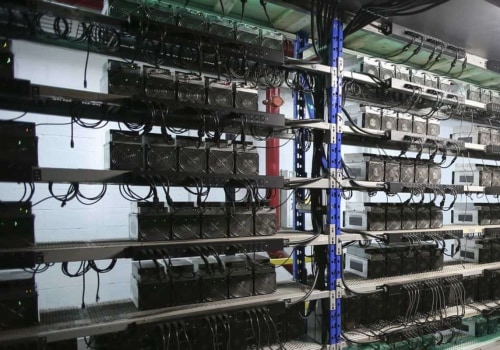Only 1 megabyte of transaction data can fit in a single bitcoin block. The 1 MB limit was set by Satoshi Nakamoto, and this has become a matter of controversy because some miners believe that the block size should increase to accommodate more data, which would mean that the Bitcoin network could process and verify transactions more quickly. Let's say I tell three friends that I'm thinking of a number between one and 100, and I write that number on a piece of paper and stamp it on an envelope. My friends don't have to guess the exact number; they just have to be the first person to guess any number that is less than or equal to it.
And there's no limit to the amount of guesswork they get. In terms of Bitcoin, simultaneous responses happen frequently, but at the end of the day, there can only be one winning answer. When multiple simultaneous responses are presented that are equal to or less than the target number, the Bitcoin network will decide by simple majority (51%) which miner to honor. As you can see here, their contribution to the Bitcoin community is that they confirmed 1,768 transactions for this block.
If you really want to see all 1,768 transactions in this block, go to this page and scroll down to the Transactions section. Participants with a small percentage of the mining power have very little chance of discovering the next block on their own. For example, a mining card that could be purchased for a couple of thousand dollars would represent less than 0.001% of the network's mining power. With such a small chance of finding the next block, it could be a long time before the miner finds a block, and the difficulty of climbing makes matters even worse.
The miner may never recover his investment. The answer to this problem is mining pools. As mentioned earlier, the easiest way to acquire Bitcoin is to simply buy it on one of the many Bitcoin exchanges. Alternatively, you can always take advantage of the peak strategy.
This is based on the old mountain range that during the California gold rush of 1849, the smart investment was not to look for gold, but to have the spikes used for mining. Bitcoin mining is the process of creating new bitcoins by solving puzzles. It consists of computer systems equipped with specialized chips that compete to solve mathematical puzzles. The first bitcoin miner (as these systems are called) to solve the puzzle is rewarded with bitcoin.
The mining process also confirms transactions on the cryptocurrency network and makes them reliable. Bitcoin mining is a computational process that achieves two distinct and important objectives. First, it allows miners to “find new bitcoins that are added to circulation. Second, bitcoin miners verify transactions while mining.
This helps ensure the integrity of the blockchain, which serves as a transaction log. Bitcoin mining is the process by which Bitcoin transactions are digitally validated on the Bitcoin network and added to the blockchain ledger. It is done by solving complex cryptographic puzzles to verify the blocks of transactions that are updated in the decentralized blockchain ledger. Solving these puzzles requires powerful computing power and equipment.
In return, miners are rewarded with Bitcoin, which is then released into circulation, hence the name Bitcoin mining. Bitcoin mining is a way for people to earn new Bitcoins by performing the process of validating Bitcoin transactions. Every miner who validates a block of transactions is rewarded with a certain amount of Bitcoin. In other words, it is a dual process that generates new coins and allows coins in circulation to be used safely.
What this means for crypto miners is that Ethereum miners have a very high risk that their machines will become obsolete overnight. Your cash flows would run out immediately and the resale value of your GPUs would drop significantly. Knowing this risk, a large majority of the capital that is deployed in cryptocurrency mining goes to Bitcoin mining, specifically. The operative text in Article 2a does not directly refer to proof-of-work consensus mechanisms, but rather refers to crypto-assets that are already in issue, putting in place a phased implementation plan to ensure compliance with minimum environmental sustainability standards.
The CryptoCompare site offers a useful calculator that allows you to connect numbers such as your hash rate and electricity costs to estimate costs and benefits. Bitcoin miners add mining systems that consume massive amounts of electricity to mine the cryptocurrency. But how can you start mining cryptocurrencies? There are a few fundamental aspects to keep in mind, whether you opt for Bitcoin or Ether. Cryptocurrency mining serves two purposes: to generate new cryptocurrencies (what we would instinctively think of as “mining”) and verifying the legitimacy of cryptocurrency transactions on your blockchain.
Cryptocurrency Mining) The competitive process that verifies and adds new transactions to the blockchain for a cryptocurrency that uses the proof-of-work (PoW) method. Bitcoin is a cryptocurrency that has gained great popularity due to its crazy price swings and is created through a process known as “mining”. But it's about more than just creating new currencies, it's also how cryptocurrency transactions are validated. It is also affected by the number of new miners who have joined the Bitcoin network because it increases the hash rate or the amount of computing power deployed to mine the cryptocurrency.
Cryptocurrencies need something called a “consensus mechanism” to ensure that all its stakeholders agree on which transactions are legitimate and to prevent people from spending the same money twice. Bitcoin is one of the most popular types of cryptocurrencies, which are digital means of exchange that exist solely online. But cryptocurrencies can be subject to huge price swings, so their mining reward could be a big reward or a small misery. .
.








